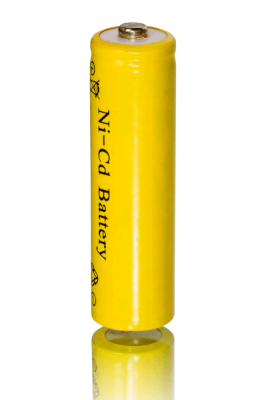What Is a Nickel-Cadmium Battery?

A nickel-cadmium battery (Ni–Cd battery or NiCad battery) is a type of rechargeable battery that uses cadmium hydroxide for the negative electrode and nickel hydroxide for the positive electrode. It can be charged and discharged.
With a long history of more than a century, these batteries have been used in various places, taking advantage of their qualities, such as the ability to discharge large currents and to withstand repeated use.
In recent years, the use of nickel-cadmium batteries and lithium-ion batteries, which do not contain cadmium and have excellent battery performance, has become mainstream, and the use of nickel-cadmium batteries is on the decline.
Uses of Nickel-Cadmium Batteries
Nickel-cadmium batteries have been used to drive motors for rechargeable tools and vacuum cleaners, and as emergency power sources, taking advantage of their resistance to overcharge and discharge and their ability to discharge large currents.
There are two types of nickel-cadmium batteries: sintered batteries are suitable for driving motors because of their high output discharge capability, and foamed batteries are suitable for power supply applications because of their relatively high capacity.
In the past, they were also used as rechargeable dry-cell batteries. However, since they are not suitable for recharging due to the memory effect, nickel-metal hydride batteries are now the mainstream.
Principle of Nickel-Cadmium Batteries
Nickel-cadmium batteries consist of electrodes and a potassium hydroxide solution as the separator (electrolyte) and have a nominal electromotive force of 1.2V.
When nickel-cadmium batteries discharge, cadmium hydroxide is formed by the reaction of water with cadmium metal at the anode in the presence of hydroxide ions, releasing hydrogen ions and electrons. On the other hand, on the positive electrode side, nickel oxyhydroxide receives hydrogen ions and electrons in the presence of water to produce nickel hydroxide.
During charging, the opposite reaction occurs as in discharging, with cadmium hydroxide receiving electrons and being reduced to cadmium at the anode, and cadmium hydroxide becoming nickel oxyhydroxide in the presence of hydroxide ions at the cathode side, releasing water and electrons.
The electrolyte and electrodes have low internal resistance due to their properties, making them suitable for high-current discharge, and even if over-discharged, performance can be restored by repeated charging and discharging. It is also capable of maintaining a voltage that can withstand use in low-temperature environments of -20 to -40°C.
Structure of Nickel-Cadmium Batteries
There are two types of nickel-cadmium batteries: cylindrical and square.
The cylindrical type consists of a nickel compound as the positive electrode, a separator made of potassium hydroxide and non-fibers, and a cadmium compound plate as the negative electrode, which is stacked and spirally wound together and inserted into an outer can. The anode and cathode contact the negative and positive terminals, respectively (or via current-collecting leads) to output electricity to the outside. In the case of the square type, the structure consists of multiple positive and negative electrode plates facing each other via separators.
The current nickel-cadmium batteries have a structure called a sealed type. When nickel-cadmium batteries were first invented, they were of the open type, but the sealed type eliminated the need for water consumption due to electrolyte decomposition and the associated replenishment fluid when overcharged. In addition, nickel-cadmium batteries are designed so that the capacity of the negative electrode is greater than that of the positive electrode. This means that even when the positive electrode is fully charged, the negative electrode remains in a discharged state, and hydrogen generation at the negative electrode is suppressed as the discharged state absorbs oxygen. This prevents rupture due to increased internal pressure as well as electrolyte consumption. In addition, nickel-cadmium batteries are equipped with a valve to vent gases in the event of an increase in internal pressure.